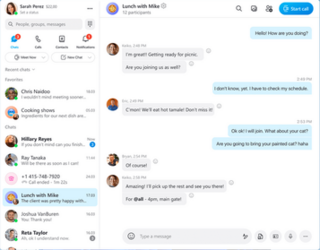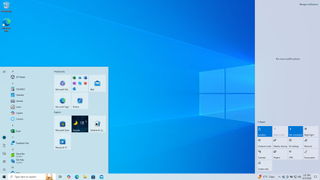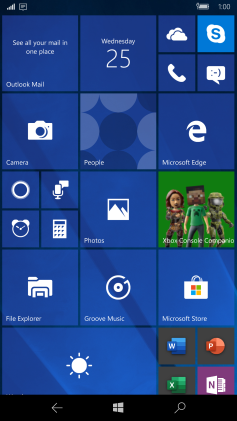Related Research Articles

Microsoft Office, or simply Office, is a family of client software, server software, and services developed by Microsoft. It was first announced by Bill Gates on August 1, 1988, at COMDEX in Las Vegas. Initially a marketing term for an office suite, the first version of Office contained Microsoft Word, Microsoft Excel, and Microsoft PowerPoint. Over the years, Office applications have grown substantially closer with shared features such as a common spell checker, Object Linking and Embedding data integration and Visual Basic for Applications scripting language. Microsoft also positions Office as a development platform for line-of-business software under the Office Business Applications brand.
Visual Basic for Applications (VBA) is an implementation of Microsoft's event-driven programming language Visual Basic 6.0 built into most desktop Microsoft Office applications. Although based on pre-.NET Visual Basic, which is no longer supported or updated by Microsoft, the VBA implementation in Office continues to be updated to support new Office features. VBA is used for professional and end-user development due to its perceived ease-of-use, Office's vast installed userbase, and extensive legacy in business.
Kopete is a multi-protocol, free software instant messaging client released as part of the KDE Software Compilation. Although it can run in numerous environments, it was designed for and integrates with the KDE Plasma Workspaces. Kopete was started because ICQ blocked Licq from their network in 2001. According to the original author, Duncan Mac-Vicar Prett, the name comes from the Chilean Spanish word copete, meaning "a drink with your friends". Kopete has been nominated for multiple awards. The designated successor is KDE Telepathy from the KDE RTCC Initiative.

Skype is a proprietary telecommunications application operated by Skype Technologies, a division of Microsoft, best known for VoIP-based videotelephony, videoconferencing and voice calls. It also has instant messaging, file transfer, debit-based calls to landline and mobile telephones, and other features. It is available on various desktop, mobile, and video game console platforms.

Skype for Business Server is real-time communications server software that provides the infrastructure for enterprise instant messaging, presence, VoIP, ad hoc and structured conferences and PSTN connectivity through a third-party gateway or SIP trunk. These features are available within an organization, between organizations and with external users on the public internet or standard phones.

Skype for Business is an enterprise software application for instant messaging and videotelephony developed by Microsoft as part of the Microsoft 365 suite. It is designed for use with the on-premises Skype for Business Server software, and a software as a service version offered as part of 365. It supports text, audio, and video chat, and integrates with Microsoft 365 components such as Exchange and SharePoint.

Messenger Plus! is an add-on for Windows Live Messenger and Skype. The software provides additional functionality to Microsoft's Instant messaging client, Windows Live Messenger, by adding its own controls to the main interface. These controls affect Messenger's behaviour and appearance, often through additional dialog boxes.

Quick Assist is a Microsoft Windows feature that allows a user to view or control a remote Windows computer over a network or the Internet to resolve issues without directly touching the unit. It is based on the Remote Desktop Protocol (RDP). It is complemented by Get Help, a feature introduced in Windows 10 that enables the user to contact Microsoft directly but does not allow for remote desktoping or screen sharing.

NonVisual Desktop Access (NVDA) is a free and open-source, portable screen reader for Microsoft Windows. The project was started by Michael Curran in 2006.

Windows Search is a content index and desktop search platform by Microsoft introduced in Windows Vista as a replacement for the previous Indexing Service of Windows 2000, Windows XP, and Windows Server 2003, designed to facilitate local and remote queries for files and non-file items in the Windows Shell and in compatible applications. It was developed after the postponement of WinFS and introduced to Windows several benefits of that platform.

Microsoft Translator is a multilingual machine translation cloud service provided by Microsoft. Microsoft Translator is a part of Microsoft Cognitive Services and integrated across multiple consumer, developer, and enterprise products, including Bing, Microsoft Office, SharePoint, Microsoft Edge, Microsoft Lync, Yammer, Skype Translator, Visual Studio, and Microsoft Translator apps for Windows, Windows Phone, iPhone and Apple Watch, and Android phone and Android Wear.
The transition from Windows 7 to Windows 8 introduced a number of new features across various aspects of the operating system. These include a greater focus on optimizing the operating system for touchscreen-based devices and cloud computing.

Windows 8.1 is a release of the Windows NT operating system developed by Microsoft. It was released to manufacturing on August 27, 2013, and broadly released for retail sale on October 17, 2013, about a year after the retail release of its predecessor, and succeeded by Windows 10 on July 29, 2015. Windows 8.1 was made available for download via MSDN and Technet and available as a free upgrade for retail copies of Windows 8 and Windows RT users via the Windows Store. A server version, Windows Server 2012 R2, was released on October 18, 2013.

Universal Windows Platform (UWP) apps are applications that can be used across all compatible Microsoft Windows devices. They are primarily purchased and downloaded via the Microsoft Store, Microsoft's digital application storefront.

Cortana was a virtual assistant developed by Microsoft that used the Bing search engine to perform tasks such as setting reminders and answering questions for users.

Windows 10 is a major release of Microsoft's Windows NT operating system. It is the direct successor to Windows 8.1, which was released nearly two years earlier. It was released to manufacturing on July 15, 2015, and later to retail on July 29, 2015. Windows 10 was made available for download via MSDN and TechNet, as a free upgrade for retail copies of Windows 8 and Windows 8.1 users via the Microsoft Store, and to Windows 7 users via Windows Update. Windows 10 receives new builds on an ongoing basis, which are available at no additional cost to users, in addition to additional test builds of Windows 10, which are available to Windows Insiders. Devices in enterprise environments can receive these updates at a slower pace, or use long-term support milestones that only receive critical updates, such as security patches, over their ten-year lifespan of extended support. In June 2021, Microsoft announced that support for Windows 10 editions which are not in the Long-Term Servicing Channel (LTSC) will end on October 14, 2025.

Windows 10 Mobile is a discontinued mobile operating system developed by Microsoft. First released in 2015, it is a successor to Windows Phone 8.1, but was marketed by Microsoft as being an edition of its PC operating system Windows 10.

Microsoft Office 2016 is a version of the Microsoft Office productivity suite. It was released on macOS on July 9, 2015, and on Microsoft Windows on September 22, 2015, for Office 365 subscribers. Support for most editions of Office 2016 will end on October 14, 2025. The perpetually licensed version on macOS and Windows was released on September 22, 2015. Office 2016 is compatible with Windows 7 SP1 and Windows Server 2008 R2 SP1 through Windows 11 v23H2 and Windows Server 2022. It also requires OS X Yosemite at the minimum. It is the last version of Microsoft Office to support Windows 7 SP1, Windows Server 2008 R2 SP1, Windows 8, Windows Server 2012, Windows 8.1, Windows Server 2012 R2, Windows 10 RTM–v1803 and Windows Server 2016.
Windows 10 introduced a number of new elements, including the option to use a touch-optimized interface or a traditional desktop interface similar to that of Windows 7 along with live tiles from Windows 8. However, unlike previous versions of Windows, where most, if not all, major features for that release were completed by its RTM, Windows 10 continues to receive major features and changes beyond its initial release to market. Microsoft describes Windows 10 as an "operating system as a service" that will receive ongoing updates to its features and functionality. This is supplemented with the ability for enterprise environments to receive non-critical updates at a slower pace, and to use long-term support milestones that will only receive critical updates, such as security patches, over their ten-year lifespan of support.

People was a contact management app and address book included in Microsoft's Windows 8 and 10. It allows a user to organize and link contacts from different email accounts. People has a unique graphical interface, unlike Windows Contacts' File Explorer-based interface, based on the Metro design language that had already been used for Outlook.com and the integrated online People service. In addition to being an address book, it provides a list of recent mail conversations with a selected contact. It used to also be a social media hub, in which users could integrate their social networking accounts, but API changes in both Windows and social media services caused this functionality to break.
References
- ↑ Rooney, Ben. "Microsoft to buy Skype for $8.5 billion".
- ↑ Van Allen, Fox (15 December 2014). "Microsoft Launches 'Skype Translator Preview'". Technilicious.
- ↑ Hernandez, Pedro (15 December 2014). "Microsoft's Skype Translator Provides On-the-Fly Translations. Say "Hola." Microsoft seeks to demolish language barriers with a preview of its near-real-time translator technology". eWeek. Archived from the original on March 16, 2016.
- ↑ "Skype Translator: Breaking down language barriers". YouTube .
- ↑ Thurrott, Paul (15 December 2014). "Microsoft Launches Skype Translator Preview. Habla Español?". SuperSite for Windows.
- ↑ "Milestones on the path to Skype Translator". Microsoft Research.
- ↑ Foley, Mary Jo (8 June 2015). "Microsoft to integrate Skype Translator functionality into its Skype desktop apps. Microsoft is folding its Skype Translator real-time translation technology into the desktop versions of its Skype apps for PCs, starting with the Windows 8.1 version". ZDNet.
- ↑ Lowensohn, Josh (28 May 2014). "Skype shown automatically translating multilingual voice calls". The Verge.
- ↑ "Bienvenue dans la version bêta de Skype Translator" (in French).
- ↑ Whitney, Lance (8 April 2015). "Skype Translator adds Mandarin and Italian to its repertoire. The translation feature for the Internet-calling service now speaks the languages of Beijing and Rome. But the translator is still available only in preview mode". CNet.
- ↑ Sieber, Tina (7 February 2015). "Can Skype Translator really help you converse in any language? We tested it to see. Skype Translator Preview brings real time text and voice translation to your desktop". Digital Trends.
- ↑ "Привет! Skype Translator says Hello to Russian". Skype Blogs. 2016-10-11. Retrieved 2016-10-11.
- ↑ "Skype Translator Preview".
- ↑ Shaw, Ray (11 August 2015). "Microsoft now speaks 50 languages – use almost any device". IT Wire.
- ↑ "Skype Translator unveils the magic to more people around the world".
- ↑ "Microsoft Translator brings end-to-end speech translation to everyone with the world's first Speech Translation API".